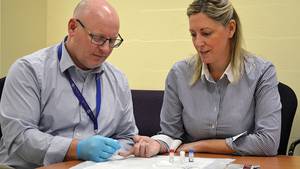Surviving a heart attack is the first step on a long road to recovery and Dr. Wael Sumaya wants to get more specific about what type of treatment each patient really needs, based on how well their body clots blood.
A cardiologist at the QEII Health Sciences Centre, Dr. Sumaya and his team of researchers are studying the effects of two different treatments on cardiology patients post heart attack. Funded by QEII Foundation donors through a Maritime Heart Centre Innovation Fund grant, Dr. Sumaya will compare the effects of the two different treatment strategies to determine the effects on markers for bleeding and clotting risk.
Dr. Sumaya was first introduced to research during his training in Sheffield, England and was awarded a PhD for his studies in this field. Blood thinners are key to improving outcomes after a heart attack. Two blood thinners are usually needed in the first year but beyond the initial period, patients have been traditionally managed with aspirin alone. However, one in five patients dies or suffers a non-fatal heart attack or stroke within three years after surviving the first year.
To try and improve outcomes, additional blood thinner therapy may be needed and Dr. Sumaya and his team will look at two different blood thinners to look for clues as to which one is safer or more effective.
The upcoming study narrows in on the health outcomes of 20 patients who experienced a heart attack more than 12 months ago and who are coping with chronic coronary syndrome, otherwise known as stable coronary artery disease. A common affliction of patients with heart disease, chronic coronary syndrome is a condition that can be altered and improved by lifestyle changes and medical interventions like the one Dr. Sumaya and his team are researching.
“I was really interested in trying to understand the mechanisms of why some patients do very well after a heart attack and why a certain percentage of patients don’t do very well,” says Dr. Sumaya. “It’s a relatively small study, but it’s a start that will help us get clues as to which treatment is better. Then it may lead to further, bigger studies in the future.”
To start finding the answers they seek, Dr. Sumaya will measure patients’ bleeding time and other blood markers of increased risk and compare the effects of the two treatment strategies.
In medicine today, there are two treatment strategies and both have been shown to improve patient outcomes, but both come with an increased risk of bleeding. Dr. Sumaya’s hypothesis suggests one of the two treatment options might have less impact on bleeding time. The team will compare the effects of these two different treatment strategies on each participant’s different markers of bleeding and clotting risk and thus determine which treatment is best for each patient group.
Study participants manage additional risk factors, like diabetes, chronic kidney disease or having experienced multiple strokes or heart attacks in the past. The study aims to compare how the two drugs affect patient outcomes, which will mark the first time these two treatment options are being studied together.
“With any anti-clotting drug, there is a penalty. Both medications improved outcomes in terms of frequent heart attacks or strokes, but then the penalty was increased risk of bleeding,” says Dr. Sumaya.
Currently, patients with chronic coronary syndrome who are taking blood thinners must be wary of cuts, scrapes and spontaneous bleeds, which are rare but worrisome for patients and their caregivers.
“It’s often very difficult to select the right patients who will benefit from intensive anti-clotting treatment. One of the goals of this study will help us define that,” says Dr. Sumaya.
The study is in collaboration with The Cardiovascular Research Group at Dalhousie University. The 12-month study will begin once approved by the Research Ethics Board. The research team will employ a crossover design, in which patients will receive one of the two treatments to start, followed by a washout period or pause from any treatments and end with the other treatment regimen. The goal is to determine which patient groups respond best to each treatment.
“We want to tease out which patients will benefit the most from more intensive therapy, while maintaining the risk of bleeding at a minimal cost,” says Dr. Sumaya.
As an interventional cardiologist, he knows the results will help give more people healthy years ahead.
“Ultimately, it’s a medical therapy that will reduce the chances of future events,” he says. “My research studies treatments that aims to reduce the chances of patients coming back with further heart attacks or strokes in the future.”







